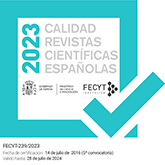Paleography and diplomatics: genesis, evolution and current trends
DOI:
https://doi.org/10.3989/ceg.2009.v56.i122.71Keywords:
Palaeography, Diplomatics, Codicology, Epigraphy, Historiographic paradigms, History of the written cultureAbstract
This article presents a succinct vision of the current state of the Paleography and Diplomatcs. Approaches his birth in the 17th century as auxiliary sciences of the history and of the philology in the area of the History of the Church. Later, it follows his evolution in the context of the birth and consolidation of the historical-critical method, of the classification and systematizing of the writing, the diverse schools of the 19th century, up to his scientific consolidation at the beginning of the 20th century. The new draft is born in mind paleographic from 1930 (A. Gieysztor and I. Hajnal) and the History of the written culture (A. Petrucci, A.B. Langeli …). His evolution is studied in addition in Spain. Later are examined the epistemologics budgets of the different historics paradigms as base of the acceptance or putting concerning the study of the sources. One concludes with the step of the erudite and descriptive paleography to a history of the uses of the writing.
Downloads
Download data is not yet available.
Downloads
Published
2009-12-30
How to Cite
García Tato, I. (2009). Paleography and diplomatics: genesis, evolution and current trends. Cuadernos De Estudios Gallegos, 56(122), 411–441. https://doi.org/10.3989/ceg.2009.v56.i122.71
Issue
Section
History
License
Copyright (c) 2009 Consejo Superior de Investigaciones Científicas (CSIC)

This work is licensed under a Creative Commons Attribution 4.0 International License.
© CSIC. Manuscripts published in both the printed and online versions of this Journal are the property of Consejo Superior de Investigaciones Científicas, and quoting this source is a requirement for any partial or full reproduction.All contents of this electronic edition, except where otherwise noted, are distributed under a “Creative Commons Attribution 4.0 International” (CC BY 4.0) License. You may read here the basic information and the legal text of the license. The indication of the CC BY 4.0 License must be expressly stated in this way when necessary.
Self-archiving in repositories, personal webpages or similar, of any version other than the published by the Editor, is not allowed.
















